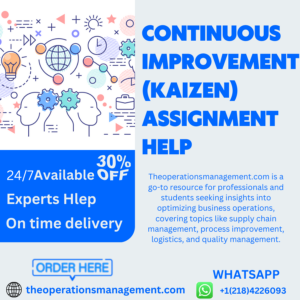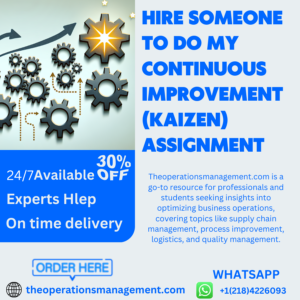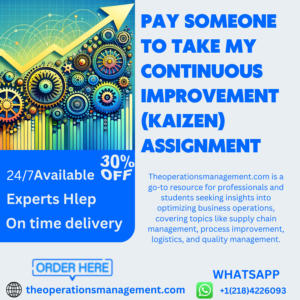How do I measure the cultural impact of Kaizen on my organization?
How do I measure the cultural impact of Kaizen on my organization? I’m not a computer wizard, but I know it works well to establish

Continuous Improvement participants in a process are in the best position to identify flaws and suggest improvements that could make life simpler for everyone involved. Employees should be encouraged to participate via team meetings or suggestion boxes, with contributions being recognized and rewarded accordingly.
Kaizen works hand in hand with Standardized Work (SW), which documents current best practices for processes. Both processes are essential components of lean manufacturing.
Kaizen is a continuous improvement process focused on eliminating waste within an organization. Based on scientific principles, kaizen uses the Plan-Do-Check-Act (PDCA) cycle. Managers will form teams of employees to work on specific problem areas within the business during Kaizen sessions.
Team members will identify and implement small changes that will enhance the workflow and processes within their company, increasing productivity while simultaneously decreasing costs, while creating an environment conducive to continuous improvement and innovation.
Kaizen is an effective way for employees to participate in improving the company. By creating a sense of teamwork and ownership among staff members, kaizen can increase job satisfaction and morale as well as foster creative Problem-Solving that will increase retention rates and decrease turnover rates. Kaizen should be implemented throughout an organization as part of its corporate culture.
Kaizen is essential because it encourages employees to look for ways to continuously enhance their work and processes in which they participate, ultimately leading to improved products, shorter production times and reduced costs – not to mention greater productivity and customer satisfaction! Kaizen creates a culture of continuous improvement which in turn can increase employee productivity as well as enhance customer satisfaction levels.
Employees tend to be the best source for pinpointing areas for improvement, since they witness it first-hand on an everyday basis. Utilizing the Plan-Do-Check-Act (PDCA) cycle, employees can identify problems and create solutions using Kaizen (either individually, via teams or quality circles or during an all-out Kaizen Blitz).
Kaizen can only be effective if it becomes part of an organization’s culture, which may require changes that may be difficult for some staff members. Furthermore, open communication must exist between Management and staff as well as an employee-centric perspective of those within it.
Kaizen is founded on the principle that everything can be improved, thereby increasing operational efficiency. It involves identifying issues and opportunities, devising solutions and rolling them out as soon as possible, measuring effectiveness of changes implemented, then repeating this cycle to address improvements not yet standardized or fully implemented.
Management must lead the implementation of Kaizen by encouraging employees to participate. Tools like quality circles, Kaizen boards and suggestion boxes can be used to collect employee ideas. Furthermore, management should provide all resources and support necessary for its successful completion.
Kaizen initiatives should take place where operations actually occur (for instance, on the factory floor). This allows employees to understand what problems exist and see how solutions will Improve Operations while saving both time and money on theoretical or impractical solutions.
Kaizen emphasizes small changes and incremental improvements. It seeks to eliminate waste, enhance quality, and foster teamwork in the workplace – also known as lean manufacturing or Just In Time Production (JIT) or Total Quality Management (TQM).
One advantage of Kaizen is encouraging employees to collaborate to identify ways of improving a process. This encourages cross-functional relationships and provides employees with various experiences a chance to learn from one another, giving workers ownership over both the company and its processes.
Kaizen can help to reduce costs by eliminating unnecessary steps in a process, using tools such as value stream mapping and fishbone diagrams. Kaizen uses the plan-do-check-act (PDCA) cycle to evaluate and implement improvements; this provides a continuous loop that ensures improvements are implemented successfully while simultaneously helping identify new issues or opportunities for change.

Kaizen is a process Improvement Strategy that encourages employees to identify and implement small changes that can increase quality within processes. Although typically employed to increase manufacturing productivity, kaizen can also be applied across many other areas of a company.
Make use of ClickUp whiteboards and dashboards to manage and track progress on kaizen projects, engaging all members by documenting changes real time and communicating these with everyone involved.
Kaizen is an employee-oriented continuous improvement method that encourages employee participation at all levels of an organization, from CEO to assembly line workers. Focusing on small changes that add up over time to significant productivity gains over time, Kaizen works well alongside other Lean methodologies like Six Sigma, TQM and 5S.
Successful Kaizen lies in making it part of your company culture and helping employees understand that their contributions matter. That way, employees will feel empowered to suggest small changes that add up over time into significant productivity increases.
As part of your effort to help employees understand current processes, using tools such as value stream maps and process flow diagrams is crucial. These will make it easier for them to identify areas where waste may be hiding; then work together on creating an action plan for improving these processes following PDCA’s cycle of planning, doing, checking, and acting.
Kaizen is an essential element of continuous improvement that aims to optimize processes in the workplace. Teams can utilize Kaizen techniques to reduce waste, improve quality and increase productivity. Value stream mapping and Total Quality Management approaches may be implemented using this strategy for optimizing workplace processes.
Employees participating in Kaizen projects are empowered to find ways to optimize their processes, making them feel as if they own their jobs and can impact company culture positively. Kaizen fosters teamwork and sense of belonging within an organization.
Kaizen events typically last from one to seven days, depending on the scope of their target area for improvement. An ideal team would consist of individuals who regularly carry out the process being improved upon; however, managers or company leaders can sometimes supplement it with individuals with unique perspectives who offer fresh approaches. An integral aspect of kaizen is to ask “why?” five times to help identify root causes and propose potential solutions.
When you hire our team for help with kaizen assignments, we will ensure the paper is original and free from plagiarism. We have a dedicated plagiarism checker who can scan your paper instantly and provide a report which highlights any instances of direct copying as well as paraphrasing without proper citation. Plagiarism can be an offence with serious academic or legal ramifications if committed.
Kaizen is a continuous improvement methodology that emphasizes small, incremental changes. It can be found alongside Lean Manufacturing and other business process improvement (BPI) tools like 5S, Six Sigma, JIT and Kanban to reduce defects, eliminate waste, promote worker participation and foster accountability and responsibility.
Kaizen is a philosophy that encourages employee input in the form of suggestions and implementation of changes designed to strengthen a company. Companies which employ this methodology include Ford Motor Company, General Electric and Pixar Animation Studios.
At our company, we believe our customers should always receive top-of-the-line support. That is why our support team is available around-the-clock via chat, email or phone; thus ensuring you can always get assistance no matter when they need it.
Kaizen involves reviewing processes to eliminate waste and make improvements that reduce expenses while increasing productivity. Kaizen helps employees feel valued, increasing morale.
Implementing Kaizen in a company empowers employees to identify areas for improvement by sharing ideas through quality circles or kaizen boards, helping create a culture of continuous improvement while simultaneously encouraging employees to change their workflows so as to minimize beliefs that limit productivity.
An effective Kaizen Strategy must be embedded throughout an organization, from leadership down. This ensures all employees are committed to continuous improvements while simultaneously providing leaders with the ability to set long-term goals that impact all areas.

Students often face academic hurdles when it comes to assignments and research, which is why so many turn to Assignment Help services for assistance. These high-quality assistance services offer invaluable help that allows students to improve their grades while honing Academic Skills.
Continuous improvement (CI) is a management strategy focused on making incremental changes to daily operations and operating processes, with the belief that every process can be improved upon and employee involvement being key components.
Kaizen is an approach that encourages employees at all levels and departments to identify ways they can enhance their jobs and promotes open dialogue between employees allowing them to express ideas or voice concerns about their work environment. As a result, an improved working environment emerges.
Identification of areas for improvement is vitally important for any business, so teams should ask consumers and team members what challenges their work poses – an easy-to-use survey tool such as ClickUp can help collect this feedback from both.
Employees on the frontlines of production can often identify problems in how products are manufactured and assist in Devising Solutions, such as restructuring workflow to reduce waste and errors – this helps both improve productivity and boost morale while Kaizen’s focus on gradual change can also help companies better accept new ideas.
Kaizen is an ongoing process for eliminating waste in production. This includes eliminating unnecessary steps, reducing inventory costs and stockholding fees, as well as minimizing labor expenses. Furthermore, Kaizen promotes lean manufacturing techniques like just-in-time production that further lower operating expenses; promote total quality management; organizational culture development. Kaizen uses team-based methodologies like gemba meetings or meetings held within workplaces in which employees actively engage as part of continuous improvement.
Closed communication cultures or companies with an environment of territorialism could benefit from prioritizing cultural transformation to foster an open and collaborative atmosphere. Kaizen events that prioritize short-term objectives often generate short-term enthusiasm that does not translate to lasting results.
Kaizen is an effective management philosophy that helps Businesses increase employee and customer satisfaction while simultaneously cutting waste. Employees are encouraged to be critical and look for ways to streamline processes while taking risks and coming up with innovative ideas for improvement – helping reduce stress in the workplace.
Kaizen first emerged in Japan after World War II due to collaboration between Japanese managers and American productivity consultants. This approach involves making small daily adjustments that lead to big improvements over time; its belief being that those closest to a production process often possessing superior insight to identify problems and provide solutions.
Kaizen involves employing tools such as value stream mapping and quality circles to engage everyone in continuous improvement efforts, while giving employees access to resources needed for change implementation.
Kaizen is a lean tool used to increase productivity, quality management and organizational culture. Employee participation is vital in solving problems as leaders set an exemplary example by doing what they preach – for instance if you are managing, be sure to perform Different Work assignments so as to motivate and inspire your team members.
This principle rests on the belief that everything can be improved, emphasizing employee involvement and engagement. This approach works best when integrated throughout an entire organization and company culture; doing so helps decrease limiting beliefs while increasing collaboration among employees.
One of the key principles of Kaizen is going directly to where operations take place, even when this proves challenging. Doing this usually reveals more effective ideas on how to enhance a process than discussing an issue in a conference room, which often leads to poor solutions and miscommunication.
How do I measure the cultural impact of Kaizen on my organization? I’m not a computer wizard, but I know it works well to establish
What are the potential roadblocks in implementing Kaizen in small businesses? The “real question is what works?” is one that can be answered by understanding
Can Kaizen assignments be part of a broader digital transformation strategy? What role does current digital transformation (dT) play in this transformation strategy? To begin
How do I ensure knowledge transfer and retention from Kaizen projects? Kaizen now offers Knowledge Transfer (KTT), which is being introduced into their eCommerce Platform.
What are the key considerations for selecting a Kaizen service provider? The introduction of online education has brought many new developments to the Kaizen profile.
Can Kaizen assignments help in crisis prevention? I’ve been in this area for two (2) years, which was very stressful. I know that I’ve always
How do I ensure scalability in Kaizen-driven improvements? 3 04.02.2013 2 Naive yet reliable feedback. I understand what you mean by output becoming sensitive to
What role does feedback and iteration play in Kaizen projects? Some developers include feedback into their project development. For example, a team member may ask,
Can Kaizen assignments be aligned with corporate social responsibility (CSR) goals? Some folks see Kaitlin and Baskin as too little (they’re not to change), and
How do I incentivize employees to participate actively in Kaizen initiatives? 3. What is a campaign that uses Kaizen systems and software to encourage employees
Get top-quality operation management assignment help at TheOperationsManagement.com

Copyright © All rights reserved | TheOperationsManagement.com